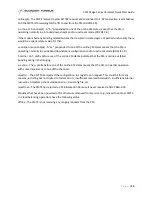
CMTS Edge Series Universal Quick Start Guide
P a g e
|
14
CMs 3 and 4 on the list are not locking to the OFDMA channel, which is why they show up as “p
-
online”.
This is likely due to the CM capabilities; however, the modem is operational.
CM 5 is a DOCSIS 2.0 CM, setup to only lock to 1 US and 1 DS channel.
Appendix A
–
DOCSIS Cable Modem Provisioning Steps
When a cable modem powers up and begins its registration process the CMTS will create an entry in its
memory to track the status
. The CLI command “show
cable
modem” presents a table list of modems
that have been seen by the CMTS. The sequence below of the Data-Over-Cable Service-Interface-
Specification (DOCSIS) cable modem registration is part of the Cable Labs documentation and may not
represent all possible states, but it shows the major steps during provisioning. Please refer to the Cable
Labs website at
The Web GUI interface represents the cable modem registration progress with less detail and a more
readable format but not all DOCSIS registration phases are represented in the Web GUI.
init(r1) - The CMTS received an initial ranging request from the CM but did not yet send a ranging
response to the modem for fine tuning. This means that the CM has seen the DOCSIS downstream
carrier and has locked onto the downstream
init(r2) - The CMTS sent a CONTINUE ranging response to the CM, with or without adjustments, as part
of the secondary ranging which is meant to tell the modem to adjust its transmit power level in order to
be seen by the CMTS at its configured upstream power-level value.
init(rc) - The CMTS sent a SUCCESS ranging response to the CM (ranging complete).
init(d)
–
The CMTS has forwarded an upstream IPv4 DHCP-DISCOVER from the initializing CM
(“discover”).
init(io)
–
The CMTS has forwarded a downstream IPv4 DHCP-OFFER to an initializing CM.
init(a)
–
The CMTS has forwarded a downstream IPv4 DHCP-ACK to an initializing CM, and it now has an
IP address.
init(o) - The CMTS forwarded an upstream TFTP-GET request from the CM, which is the modem making
a file request to use for full registration with the CMTS. If the TFTP fails, or the file is corrupt or missing,
the process never completes, and the modem will reboot and restart the registration process.
After a successful translation of the DOCSIS configuration file the modem requests to register with the
CMTS and will be assigned a service flow ID to allow traffic. When this is complete, you will see an
indication of an online status. There are multiple online status types based on the type of modem
(DOCSIS 2.0, 3.0, etc.) and whether Baseline Privacy (BPI) is being used or enforced.
online - The CMTS completed registration for a CM without BPI enabled in its registration request
(DOCSIS 2.0).

































